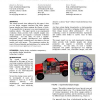Free Online Productivity Tools
i2Speak
i2Symbol
i2OCR
iTex2Img
iWeb2Print
iWeb2Shot
i2Type
iPdf2Split
iPdf2Merge
i2Bopomofo
i2Arabic
i2Style
i2Image
i2PDF
iLatex2Rtf
Sci2ools
UIST
1995
ACM
1995
ACM
An Experimental Evaluation of Transparent User Interface Tools and Information Content
The central research issue addressed by this paper is how we can design computer interfaces that better support human attention and better maintain the fluency of work. To accomplish this we propose to use semi-transparent user interface objects. This paper reports on an experimental evaluation which provides both valuable insights into design parameters and suggests a systematic evaluation methodology. For this study, we used a variablytransparent tool palette superimposed over different background content, combining text, wire-frame or line art images, and solid images. The experiment explores the issue of focused attention and interference, by varying both visual distinctiveness and levels of transparency.
Central Research Issue | Semi-transparent User Interface | Software Engineering | Support Human Attention | UIST 1995 |
| Added | 26 Aug 2010 |
| Updated | 26 Aug 2010 |
| Type | Conference |
| Year | 1995 |
| Where | UIST |
| Authors | Beverly L. Harrison, Gordon Kurtenbach, Kim J. Vicente |
Comments (0)

